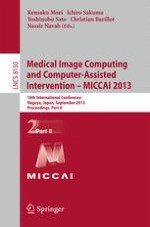The three-volume set LNCS 8149, 8150, and 8151 constitutes the refereed proceedings of the 16th International Conference on Medical Image Computing and Computer-Assisted Intervention, MICCAI 2013, held in Nagoya, Japan, in September 2013. Based on rigorous peer reviews, the program committee carefully selected 262 revised papers from 789 submissions for presentation in three volumes. The 86 papers included in the second volume have been organized in the following topical sections: registration and atlas construction; microscopy, histology, and computer-aided diagnosis; motion modeling and compensation; segmentation; machine learning, statistical modeling, and atlases; computer-aided diagnosis and imaging biomarkers; physiological modeling, simulation, and planning; microscope, optical imaging, and histology; cardiology; vasculatures and tubular structures; brain segmentation and atlases; and functional MRI and neuroscience applications.
